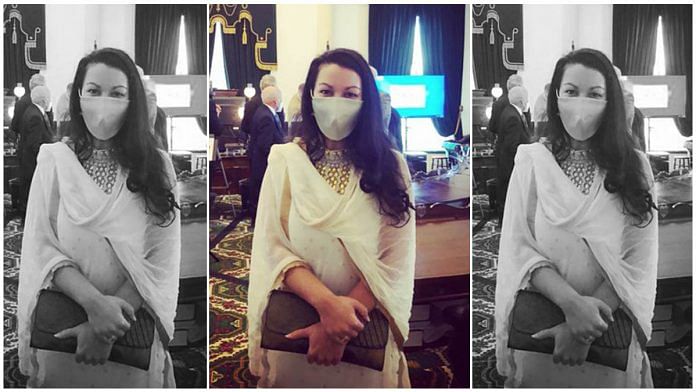
New Delhi: When Kesha Ram was sworn in as a US senator earlier this month, she became the first woman of colour to have been elected to serve in the Vermont state Senate.
Kesha is the is the great great-granddaughter of Rai Bahadur Sir Ganga Ram, noted philanthropist after whom Delhi’s Sir Ganga Ram hospital is named.
The US Consulate General Lahore Tuesday posted a tweet about Kesha Ram, who wore a salwar kameez (a traditional South Asian dress) for her swearing-in ceremony on 6 January as Vermont Senator.
In response to the viral tweet, Kesha thanked people for helping her understand Sir Ganga Ram’s legacy. “I was told that people in Lahore say a prayer for my great-great grandfather daily. I didn’t understand his impact, particularly in health care and women’s education, until that day. Thank you all for helping me understand his legacy so I can continue it,” she posted.
When I came to #VT @saleem_ali told me people in Lahore say a prayer for my great great grandfather daily. I didn’t understand his impact, particularly in health care and women’s education, until that day. Thank you all for helping me understand his legacy so I can continue it. https://t.co/NTIiDL0L1A
— Kesha Ram (@KeshaRam) January 26, 2021
On the day of her swearing-in, Kesha Ram had said she wore a salwar kameez for those who will come after her and want to “bring their whole selves into the halls of power”.
Sworn in to the #VT Senate today. I wore white for those who came before me and made this day possible, and I wore a salwar kameez for those who will come after me that want to bring their whole selves into the halls of power. Let’s get to work for Vermonters. #vtpoli pic.twitter.com/P032zBB30z
— Kesha Ram (@KeshaRam) January 6, 2021
Kesha’s father Mukul Ram had migrated to the US during the late 1960s for higher studies at the University of California, Los Angeles, and stayed on. Her mother is a Jewish-American.
Kesha grew up in California and studied at the University of Vermont where she served as student body president.
In 2008, she graduated and ran for the Vermont House and won a seat as the country’s youngest legislator at 21. However, she took a break from politics after she lost the 2016 Democratic primary race for lieutenant governor in Vermont.
Who was Sir Ganga Ram?
Sir Ganga Ram was born in 1851 in a small town called Mangtanwala, about 64 kilometres from Lahore. He graduated as an engineer from the famous Thompson Engineering College at Roorkee (now IIT Roorkee) on scholarship and was awarded a gold medal.
In 1900, he was selected by Lord Curzon to act as superintendent of works in the imperial darbar to be held in connection with the accession of King Edward the Seventh. Sir Ganga Ram had been the executive engineer of Lahore for a period of 12 years, which is called the ‘Ganga Ram period of architecture’.
He is also described as the ”father of modern Lahore”. The famous Sir Ganga Ram Hospital exists in Lahore too which was established by him, while the one in Delhi was established by his family in the 1950s when they moved to India after Partition.
Recalling her great-great grandfather’s legacy, Kesha, in an interview on 16 January, said public service is in her blood.
“My aunt, Baroness Shreela Flather, was the first South Asian woman appointed to the House of Lords, and my great-great-grandfather, Sir Ganga Ram, was knighted for his philanthropy and work to advance women’s rights at the turn of the last century. I am a descendant from those who helped shape the world’s largest democracy, and I have a lot to offer to help democracy endure through a pivotal moment in history,” she had said.
In another interview, Kesha mentioned that she came to India in 2015 and took her father’s ashes to the holy river. During that visit, she also visited Delhi’s Sir Ganga Ram Hospital where her relatives now lead the board of directors.
Also read: Biden has named 20 Indian-Americans to key positions in his team—Here’s who they are

COMMENTS